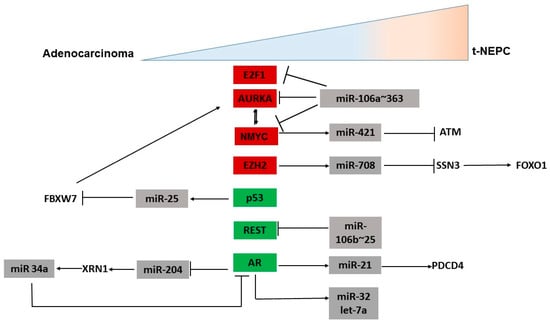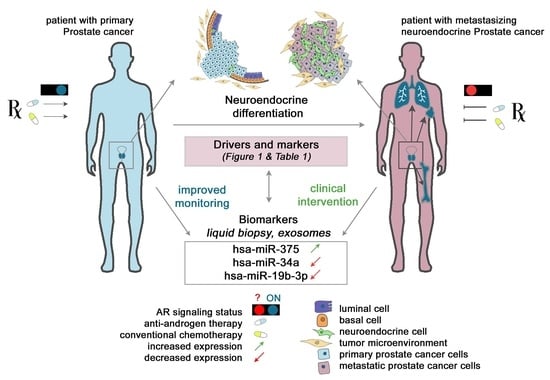Role of microRNA in Neuroendocrine Neoplasms
Share This Topical Collection
Editor
 Dr. Neil Renwick
Dr. Neil Renwick
 Dr. Neil Renwick
Dr. Neil Renwick
E-Mail
Website
Collection Editor
Laboratory of Translational RNA Biology, Department of Pathology and Molecular Medicine, Queen’s University, 88 Stuart St, Kingston, ON K7L 3N6, Canada
Interests: rare cancer; microRNA; microRNA genetics; microRNA expression; microRNA targeting; microRNA dysregulation; disease mechanisms; disease models; microRNA diagnostics; microRNA therapeutics
Special Issues, Collections and Topics in MDPI journals
Topical Collection Information
Dear Colleagues,
Neuroendocrine neoplasms are highly heterogeneous tumors that are incompletely understood at the molecular level. Diagnosis is frequently delayed, pathologic classification can be challenging, and many patients develop non-curable metastatic disease. microRNAs (miRNAs) are small RNA regulatory molecules that negatively regulate gene expression. These molecules are often dysregulated in tumorigenic processes and can also be used as disease biomarkers. Over the past decade, it has become increasingly clear that miRNAs mediate multiple aspects of neuroendocrine neoplasia and have clinical diagnostic utility. In this Topical Collection, we focus on clinical, biological, and computational studies of miRNA-mediated gene regulation and dysregulation in all NENs (including lung carcinoids, small cell lung carcinoma, gastroenteropancreatic NENs, Merkel cell carcinoma, medullary thyroid cancer, pituitary adenoma, neuroblastoma, paraganglioma, pheochromocytoma, etc.). A full understanding of miRNA changes in these diverse neoplasms will advance our knowledge of NEN biology and pave the way for novel diagnostic, prognostic, predictive, and therapeutic approaches.
We look forward to receiving your contribution to this Topical Collection.
Dr. Neil Renwick
Collection Editor
Manuscript Submission Information
Manuscripts should be submitted online at www.mdpi.com by registering and logging in to this website. Once you are registered, click here to go to the submission form. Manuscripts can be submitted until the deadline. All submissions that pass pre-check are peer-reviewed. Accepted papers will be published continuously in the journal (as soon as accepted) and will be listed together on the collection website. Research articles, review articles as well as short communications are invited. For planned papers, a title and short abstract (about 100 words) can be sent to the Editorial Office for announcement on this website.
Submitted manuscripts should not have been published previously, nor be under consideration for publication elsewhere (except conference proceedings papers). All manuscripts are thoroughly refereed through a single-blind peer-review process. A guide for authors and other relevant information for submission of manuscripts is available on the Instructions for Authors page. Non-Coding RNA is an international peer-reviewed open access semimonthly journal published by MDPI.
Please visit the Instructions for Authors page before submitting a manuscript.
The Article Processing Charge (APC) for publication in this open access journal is 1800 CHF (Swiss Francs).
Submitted papers should be well formatted and use good English. Authors may use MDPI's
English editing service prior to publication or during author revisions.
Keywords
- neuroendocrine neoplasms
- microRNA
- microRNA-mediated gene regulation
- microRNA-guided diagnostics
- microRNA pathomechanisms
- microRNA therapeutics
Published Papers (5 papers)
Open AccessArticle
MicroRNA and Metabolic Profiling of a Primary Ovarian Neuroendocrine Carcinoma Pulmonary-Type Reveals a High Degree of Similarity with Small Cell Lung Cancer
by
Stefano Miglietta, Giulia Girolimetti, Lorena Marchio, Manuela Sollazzo, Noemi Laprovitera, Sara Coluccelli, Dario De Biase, Antonio De Leo, Donatella Santini, Ivana Kurelac, Luisa Iommarini, Anna Ghelli, Davide Campana, Manuela Ferracin, Anna Myriam Perrone, Giuseppe Gasparre and Anna Maria Porcelli
Viewed by 2521
Abstract
Small cell neuroendocrine carcinoma is most frequently found in the lung (SCLC), but it has been also reported, albeit with a very low incidence, in the ovary. Here, we analyze a case of primary small cell carcinoma of the ovary of pulmonary type
[...] Read more.
Small cell neuroendocrine carcinoma is most frequently found in the lung (SCLC), but it has been also reported, albeit with a very low incidence, in the ovary. Here, we analyze a case of primary small cell carcinoma of the ovary of pulmonary type (SCCOPT), a rare and aggressive tumor with poor prognosis, whose biology and molecular features have not yet been thoroughly investigated. The patient affected by SCCOPT had a residual tumor following chemotherapy which displayed pronounced similarity with neuroendocrine tumors and lung cancer in terms of its microRNA expression profile and mTOR-downstream activation. By analyzing the metabolic markers of the neoplastic lesion, we established a likely glycolytic signature. In conclusion, this in-depth characterization of SCCOPT could be useful for future diagnoses, possibly aided by microRNA profiling, allowing clinicians to adopt the most appropriate therapeutic strategy.
Full article
►▼
Show Figures
Open AccessFeature PaperReview
Role of MicroRNAs in Neuroendocrine Prostate Cancer
by
Amritha Sreekumar and Sharanjot Saini
Cited by 6 | Viewed by 4681
Abstract
Therapy-induced neuroendocrine prostate cancer (t-NEPC/NEPC) is an aggressive variant of prostate cancer (PCa) that frequently emerges in castration-resistant prostate cancer (CRPC) under the selective pressure of androgen receptor (AR)-targeted therapies. This variant is extremely aggressive, metastasizes to visceral organs, tissues, and bones despite
[...] Read more.
Therapy-induced neuroendocrine prostate cancer (t-NEPC/NEPC) is an aggressive variant of prostate cancer (PCa) that frequently emerges in castration-resistant prostate cancer (CRPC) under the selective pressure of androgen receptor (AR)-targeted therapies. This variant is extremely aggressive, metastasizes to visceral organs, tissues, and bones despite low serum PSA, and is associated with poor survival rates. It arises via a reversible trans-differentiation process, referred to as ‘neuroendocrine differentiation’ (NED), wherein PCa cells undergo a lineage switch and exhibit neuroendocrine features, characterized by the expression of neuronal markers such as enolase 2 (ENO2), chromogranin A (CHGA), and synaptophysin (SYP). The molecular and cellular mechanisms underlying NED in PCa are complex and not clearly understood, which contributes to a lack of effective molecular biomarkers for diagnosis and therapy of this variant. NEPC is thought to derive from prostate adenocarcinomas by clonal evolution. A characteristic set of genetic alterations, such as dual loss of retinoblastoma (
RB1) and tumor protein (
TP53) tumor suppressor genes and amplifications of Aurora kinase A (
AURKA),
NMYC, and
EZH2, has been reported to drive NEPC. Recent evidence suggests that microRNAs (miRNAs) are important epigenetic players in driving NED in advanced PCa. In this review, we highlight the role of miRNAs in NEPC. These studies emphasize the diverse role that miRNAs play as oncogenes and tumor suppressors in driving NEPC. These studies have unveiled the important role of cellular processes such as the EMT and cancer stemness in determining NED in PCa. Furthermore, miRNAs are involved in intercellular communication between tumor cells and stromal cells via extracellular vesicles/exosomes that contribute to lineage switching. Recent studies support the promising potential of miRNAs as novel diagnostic biomarkers and therapeutic targets for NEPC.
Full article
►▼
Show Figures
Open AccessFeature PaperReview
Regulation of Neuroendocrine-like Differentiation in Prostate Cancer by Non-Coding RNAs
by
Eva Slabáková, Zuzana Kahounová, Jiřina Procházková and Karel Souček
Cited by 4 | Viewed by 5123
Abstract
Neuroendocrine prostate cancer (NEPC) represents a variant of prostate cancer that occurs in response to treatment resistance or, to a much lesser extent,
de novo. Unravelling the molecular mechanisms behind transdifferentiation of cancer cells to neuroendocrine-like cancer cells is essential for development
[...] Read more.
Neuroendocrine prostate cancer (NEPC) represents a variant of prostate cancer that occurs in response to treatment resistance or, to a much lesser extent,
de novo. Unravelling the molecular mechanisms behind transdifferentiation of cancer cells to neuroendocrine-like cancer cells is essential for development of new treatment opportunities. This review focuses on summarizing the role of small molecules, predominantly microRNAs, in this phenomenon. A published literature search was performed to identify microRNAs, which are reported and experimentally validated to modulate neuroendocrine markers and/or regulators and to affect the complex neuroendocrine phenotype. Next, available patients’ expression datasets were surveyed to identify deregulated microRNAs, and their effect on NEPC and prostate cancer progression is summarized. Finally, possibilities of miRNA detection and quantification in body fluids of prostate cancer patients and their possible use as liquid biopsy in prostate cancer monitoring are discussed. All the addressed clinical and experimental contexts point to an association of NEPC with upregulation of miR-375 and downregulation of miR-34a and miR-19b-3p. Together, this review provides an overview of different roles of non-coding RNAs in the emergence of neuroendocrine prostate cancer.
Full article
►▼
Show Figures
Open AccessReview
MicroRNAs as Potential Biomarkers in Pituitary Adenomas
by
Simone Donati, Cinzia Aurilia, Gaia Palmini, Francesca Miglietta, Irene Falsetti, Teresa Iantomasi and Maria Luisa Brandi
Cited by 7 | Viewed by 3813
Abstract
Pituitary adenomas (PAs) are one of the most common lesions of intracranial neoplasms, occurring in approximately 15% of the general population. They are typically benign, although some adenomas show aggressive behavior, exhibiting rapid growth, drug resistance, and invasion of surrounding tissues. Despite ongoing
[...] Read more.
Pituitary adenomas (PAs) are one of the most common lesions of intracranial neoplasms, occurring in approximately 15% of the general population. They are typically benign, although some adenomas show aggressive behavior, exhibiting rapid growth, drug resistance, and invasion of surrounding tissues. Despite ongoing improvements in diagnostic and therapeutic strategies, late first diagnosis is common, and patients with PAs are prone to relapse. Therefore, earlier diagnosis and prevention of recurrence are of importance to improve patient care. MicroRNAs (miRNAs) are short non-coding single stranded RNAs that regulate gene expression at the post-transcriptional level. An increasing number of studies indicate that a deregulation of their expression patterns is related with pituitary tumorigenesis, suggesting that these small molecules could play a critical role in contributing to tumorigenesis and the onset of these tumors by acting either as oncosuppressors or as oncogenes, depending on the biological context. This paper provides an overview of miRNAs involved in PA tumorigenesis, which might serve as novel potential diagnostic and prognostic non-invasive biomarkers, and for the future development of miRNA-based therapeutic strategies for PAs.
Full article
►▼
Show Figures
Open AccessReview
MiRNA Expression in Neuroendocrine Neoplasms of Frequent Localizations
by
Alexandra Korotaeva, Danzan Mansorunov, Natalya Apanovich, Anna Kuzevanova and Alexander Karpukhin
Cited by 14 | Viewed by 3545
Abstract
Neuroendocrine neoplasms (NEN) are infrequent malignant tumors of a neuroendocrine nature that arise in various organs. They occur most frequently in the lungs, intestines, stomach and pancreas. Molecular diagnostics and prognosis of NEN development are highly relevant. The role of clinical biomarkers can
[...] Read more.
Neuroendocrine neoplasms (NEN) are infrequent malignant tumors of a neuroendocrine nature that arise in various organs. They occur most frequently in the lungs, intestines, stomach and pancreas. Molecular diagnostics and prognosis of NEN development are highly relevant. The role of clinical biomarkers can be played by microRNAs (miRNAs). This work is devoted to the analysis of data on miRNA expression in NENs. For the first time, a search for specificity or a community of their functional characteristics in different types of NEN was carried out. Their properties as biomarkers were also analyzed. To date, more than 100 miRNAs have been characterized as differentially expressed and significant for the development of NEN tumors. Only about 10% of the studied miRNAs are expressed in several types of NEN; differential expression of the remaining 90% was found only in tumors of specific localizations. A significant number of miRNAs have been identified as potential biomarkers. However, only a few miRNAs have values that characterized their quality as markers. The analysis demonstrates the predominant specific expression of miRNA in each studied type of NEN. This indicates that miRNA’s functional features are predominantly influenced by the tissue in which they are formed.
Full article
►▼
Show Figures
Planned Papers
The below list represents only planned manuscripts. Some of these
manuscripts have not been received by the Editorial Office yet. Papers
submitted to MDPI journals are subject to peer-review.
Title: miRNA-mRNA target interactions in lung neuroendocrine tumor cell lines
Authors: Neil Renwick
Affiliation: Laboratory of Translational RNA Biology; Department of Pathology and Molecular Medicine; Queen's University
Abstract: none











